#P-63 Kingcobra
Explore tagged Tumblr posts
Text

Vintage Flight over Coachella Valley
From front to back:
1945 Bell P-63 Kingcobra "Pretty Polly"
1951 North American T-28A Trojan
19?? Grumman C-1 Trader
73 notes
·
View notes
Text
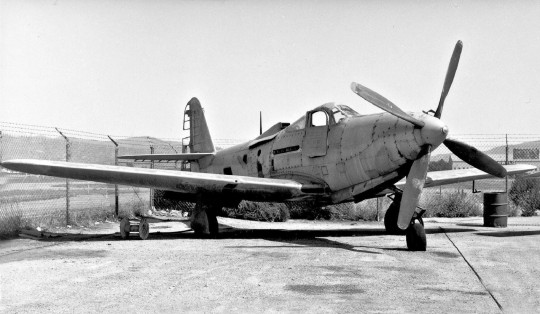
Bell P-63C Kingcobra. N163FS. Possibly at Van Nuys. ca 1960. Somewhat neglected.
178 notes
·
View notes
Text

P-63 Kingcobra fightersat Buffalo Airfield, New York before being sent to the USSR
20 notes
·
View notes
Text
There are only six airworthy B-17 Flying Fortress left in the world out of the 12,731 produced, but not too long ago there were seven.
With Masters of the Air recently coming out, I’ve been thinking about the B-17 a lot lately.
Especially her.
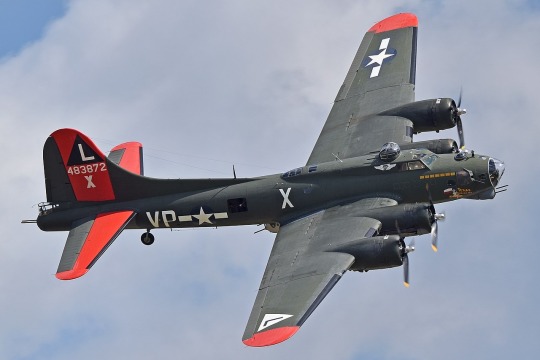
Produced on July 12, 1945, Texas Raiders was one of the last 20 B-17s ever built yet she racked up 3,257 flight hours flying for the US Navy, the fifth most out of all B-17s. In 1967, she was bought and restored to wartime configuration, going on to fly airshows all over North America with the Commemorative Air Force.
On November 22, 2022, she was involved in a midair collision with a P-63 Kingcobra during the Wings Over Dallas airshow.
All five crew aboard the B-17 and the solo pilot of the P-63 were tragically lost.

We could sit and go over the details again and again, figure out why and how it happened, who was at fault, but that’s not our job. Leave that to the FAA. Flying in airshows, especially older warbirds, has never been without risk. They loved to fly, continuing the legacy of the B-17 Flying Fortress and those who served with her through living history. We can’t let ourselves be brought to the ground by the weight of their loss when they wanted nothing more than to keep ‘em flying.
All we can do is remember them.
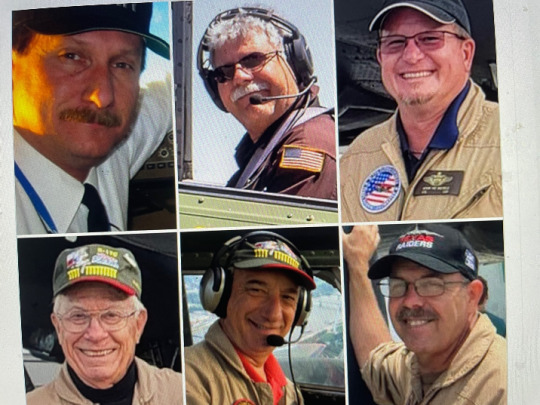
Terry Barker of Keller, TX
Craig Hutain of Montgomery, TX
Kevin “K5” Michels of Austin, TX
Dan Ragan of Dallas, TX
Leonard Root of Fort Worth, TX
Curt Rowe of Hillard, OH
#Fly High Texas Raiders 🩵#fly high flyboys 🩵#episode 3 emotional wrecked me and i knew it was coming#so I’m in sad flyboy hours#we gotta remember all those who served of course but this is merely a b-17 appreciation post#b-17 Flying Fortress#p-63 king cobra#aviation#masters of the air#mota
52 notes
·
View notes
Text

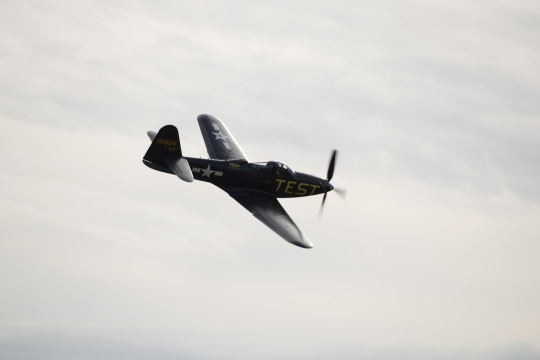
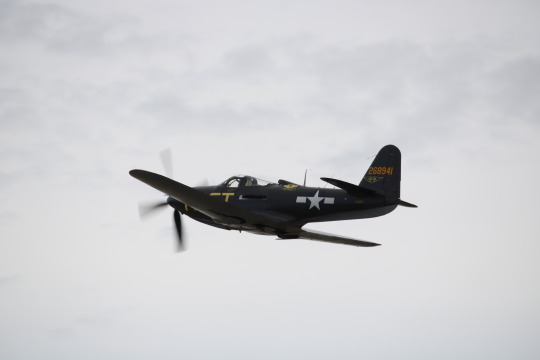


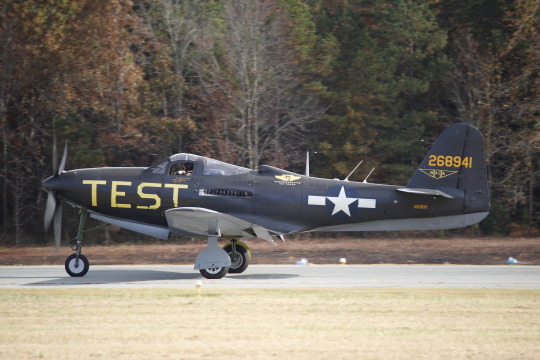
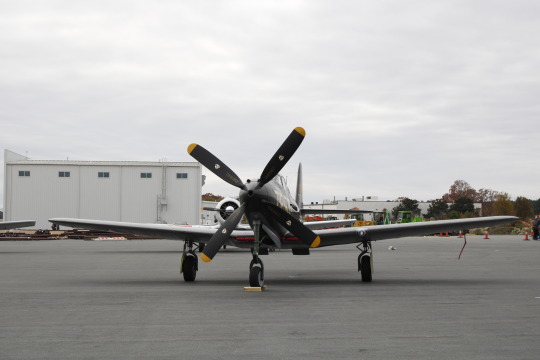



Bell P-63 Kingcobra Taken: 11/12/23
#photography#original photography#photographers on tumblr#color photography#canon eos 2000d#canon t7#north carolina#warbird#airplane#aviation#Warbirds Over Monroe#air show#aircraft#DKTAfavorite
21 notes
·
View notes
Text
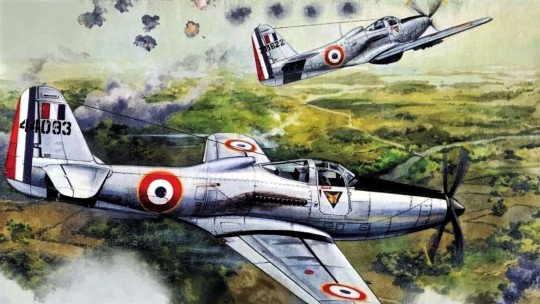
1948 Bell P-63C Kingcobra - box art Toko
Bell P-63C "Kingcobra" FIGHTER In 1941 the society "Bell" has begun to develop on the basis of the plane "P-39" a new plane for more stronger motor and with improved aerodynamics. This plane version had a little greater overall dimensions and the wing with a laminar profile. Due to the fact that the new motor has not been finished the first prototypes made flights with the motor "Alison" V1710-4 7. The flight tests continued till 1944. In summer 1944 the plane has been denominated "Kingcobra". At the end of the World War II the new planes begin to enter for the armoury of the restored military air forces of France (Armee de l'Air). The first five planes have been adopted to the armament on the 26 of July 1945. A part of mahines has been at once sent to lndo-China to be assembled at place. In Vietnam P- 63C "Kingcobra" had a good reputation. The fighters P-63C of the group "Auvergne", "lie de France", "Normandie-Niemen" and "Limousin" acted as the planes of a direct support in the battles against the army of Viet Minh. "Kingcobra" took part in all the operations without yielding to "Spitfires". The career of P-63 in the french military air forces was shortened by the absence of spare parts. At the end of 1950 "Kingcobra" began to be replaced by "Hellcats" and 1951 by "Bircats". The planes "Kingcobra" were adopted in the fighters groups (GC) 1/5 "Vendee", 11/5 "lie de France", 11/6 "NormandieÂNiemen",111/6 "Russillion", 1/9 "Limousin" an0 11 /9 "Auvergne". "Kingcobra" could carry three bombs of 227 kg under the wing and fuselage.
10 notes
·
View notes
Text
Learning the cursed airplane facts today
Although the P-63 never served with the USAAF in any combat role, it was, however, to serve with the USAAF in an another completely different capacity. This was, in fact, one of the most strange and bizarre roles ever fulfilled by any military aircraft, namely that of manned flying target! The first flying target Kingcobras were created by taking five P-63A-9s off the production line, redesignating them RP-63A-11, and subjecting them to extensive modifications. First, they were stripped of all armament. Next, all internal armor was removed. The wings, tail, fuselage, and rear canopy were then reskinned with over a ton of heavy sheet metal. A special frangible bullet for firing by gunnery students was designed. The bullet was manufactured of lead and graphite compound, so chosen that the bullet would easily shatter upon impact. Pressure-sensitive plates were fitted to the skin so that hits by the frangible ammunition on the airplane could be recorded. A light in the propeller hub (situated where the cannon used to be) would flash whenever a hit was registered, causing crews to give the aircraft the nickname "Pinball". The name stuck.
3 notes
·
View notes
Text

Palm Springs Air Museum's rare 1945 Bell P-63A Kingcobra "Pretty Polly" at Chino Valley Airport
118 notes
·
View notes
Photo

Bell P-59 Airacomet. America's first jet made its maiden flight in 1942. Pictured with P-39 (top) and P-63 (mid) escorts
191 notes
·
View notes
Text

F4U-4 Corsair To Be Loaned To Fagen Fighters WWII Museum
August 21, 2023 Angela Decker Aviation Museum News 0
John Sinclair giving instruction to Evan Fagen in the Corsair. Photo via Fagen Fighters Museum
Aircorps Art Dec 2019
by Adam Estes
The Fagen Fighters WWII Museum in Granite Falls, Minnesota, has just announced that will display F4U-4 Corsair BuNo 97388 through a loan agreement with owners

Photo via Fagen Fighters Museum
Bureau Number 97388 was taken on strength with the US Navy on April 26, 1946 and delivered four days later on April 30. The first two years of its service life would see it being assigned to several Naval Air Stations on the West Coast, such as Tillamook from June 1946 to October 1947, Santa Ana until March 1948, and San Diego until October of that year, when it was transferred to Marine Fighter Squadron 225 (VMF-225) at MCAS Cherry Point, North Carolina. June of 1949 would see 97388 sent to join VMF-212, which was in Japan at that time. Though the aircraft’s recorded history with VMF-212 contains no specific dates or locations for which exact bases in Japan it served at, the squadron would become involved in air operations at the outset of the Korean War. In the first two months of the conflict, it is highly probable that 97388 took part in combat missions launched from Japan to stem the tide of the initial North Korean advance into South Korea. Its time in combat would be cut short, however, as the aircraft would be sent back to the US in August of 1950 for overhaul and maintenance at NAS Quonset Point, Rhode Island before it would be reassigned to Fleet Air Service Squadron 3 at NAS Norfolk, Virginia. The following month, on September 14, BuNo 97388 would be assigned to VF-42. This posting would see the Corsair flying from NAS Oceana and NAS Jacksonville before being taken on a tour of the Mediterranean aboard the light carrier USS Saipan (CVL-48) from May to June of 1951, before being sent to NAS Cecil Field, Florida two months later. After a final deployment with VF-42 at NAS Oceana from November 1951 to May 1951, 97388 would undergo maintenance and overhaul at NAS Quonset Point until January 1953, when the aircraft was used primarily for reserve training at NAS Olathe, Kansas and NAS Grosse Ile, Michigan. In June of 1956, the aircraft was sent into storage at NAS Litchfield Park, Arizona before being decommissioned the following month.
After sitting outdoors at Litchfield Park, the aircraft was purchased by aircraft trader and pilot Bob Bean on November 25, 1957, who registered the Corsair as N5211V. One year later, Bean would later arrange for a trade between himself and the Honduran Air Force (Fuerza Aérea Hondureña, FAH) where 10 Corsairs (including 97388) would be shipped to Honduras in exchange for four P-38 Lightnings and four P-63 Kingcobras. In the FAH, 97388 would be identified as serial number 610, and while other Honduran Corsairs would later see combat in the Football War against El Salvador in 1969, FAH 610 had been struck off charge at the FAH Air Base at Toncontin International Airport in the capital city of Tegucigalpa, serving a source of spare parts to keep the other Corsairs flying.

Photo via Fagen Fighters Museum
FAH 610 would remain at Toncontin until 1978, when it was one of seven Honduran Corsairs returned to the United States by George Heaven & Jim Nettle of Hollywood Wings in Long Beach, California. By this point, the airframe was more a collection of parts then an airplane, and would require extensive restoration work to bring back into the skies. It would be stored in Long Beach until 1981, when it was purchased by Earl Ware of Jacksonville, who then kept the fuselage remains in his backyard, along with three other incomplete Honduran Corsairs (These being FAH 611 (USN BuNu 97382), FAH 617 (BuNo 97059), and FAH 692) until it was sold in 1982 to famed warbird restorer and pilot Gerald “Gerry” Beck of North Dakota, who would go on to spend the next 16 years meticulously returning 97388 back to airworthy condition at his shopTri-State Aviation in Wahpeton. When completed, 97388 emerged from the workshop in the markings it wore when assigned to VF-42.
After making its first post-restoration flights in 1998, Beck and 97388 would appear at EAA Airventure later that year. Over the years, 97388 would make appearances at numerous airshows and was a regular at the Fargo Air Museum in Fargo, North Dakota during the offseason, though it would later become a yearlong resident of Fargo as Beck focused on his “homebuilt” P-51A “Precious Metal II”. With the tragic death of Beck in 2007, his wife Cindy retained the Corsair and would ferry it back from Fargo to Wahpeton for refurbishment. Once completed by Tri-State in December of 2016, 97388 would be displayed at the Wings of the North Air Museum in Eden Prairie, Minnesota and was a feature of museum events such as AirExpo. With the unfortunate news of the museum’s public closure and ongoing search for a new home, Cindy and Whitney Beck have now decided to loan the Corsair to the Fagen Fighters WWII Museum. Given the wide variety of aircraft at Fagen’s expanding museum, it is indeed fortunate that 97388 has a secure home to continue flying the Midwestern skies. For more information about the Fagen Fighters WWII Museum, visit www.fagenfighterswwiimuseum.org.
6 notes
·
View notes
Text

WINGS OVER DALLAS
Event’s fate is still up in the air
Nearly two years after midflight crash killed 6, federal inquiry nears end
The federal investigation of the midair collision between two World War II-era aircraft that killed six experienced crewmen in front of a large crowd in Dallas almost two years ago is nearing a close, while the fate of the air show remains undecided.
The National Transportation Safety Board launched an investigation soon after the crash between a Boeing B-17 Flying Fortress and a Bell P-63 Kingcobra during the Commemorative Air Force’s annual Wings Over Dallas event at Dallas Executive Airport.
The victims
The crash on Nov. 12, 2022, killed Terry Barker, Craig Hutain, Kevin Michels, Dan Ragan, Lloyd “Len” Root and Curtis Rowe. No one else was injured.
Though the NTSB has not yet published a cause for the crash, some information tied to the collision has been released, including the NTSB’s preliminary report, the air traffic control recording from moments before the collision, and roughly 2,000 pages of documents tied to the investigation.
The status of the investigation is listed as “ongoing” on the agency’s website.
In the days after the crash, the agency said the investigation would be a “long process” with the final report likely to take 12 to 18 months to complete. Now, officials say the report is likely to be published closer to the two-year mark.
“We are in the final stages of that investigation,” an NTSB spokesperson wrote in an email last week. “The accident report is expected to be published in the coming weeks.”
The aftermath
Wings Over Dallas, first held in 2016, hasn’t resumed since the crash, and no decision has been made on whether it will.
The Commemorative Air Force hosted its annual Veterans Day event without an air show last year, restructuring it to have more of a festival atmosphere.
The event, deemed Aviation Discovery Fest, returned for a second year earlier this month sans an air show.
More than 6,000 people attended both years.
Although organizers last year said they intended to bring back the air show in 2024 and although the organization hosts air shows throughout Texas, including the CAF Wings Over Houston air show the weekend beofe last this past weekend, the Commemorative Air Force has not determined whether it will resume hosting air shows in Dallas, the group’s vice president of marketing, Leah Block, said in an Oct. 28 email.
At least two lawsuits stemming from the crash are pending.
The wife and daughters of Len Root, a retired American Airlines pilot who was the copilot of the B-17 Flying Fortress, filed a lawsuit August 2023 in Dallas County against the Commemorative Air Force, American Airpower Heritage Flying Museum Inc. and American Airpower Heritage Museum Inc.
The mother, wife and sons of Terry Barker, also a former American Airlines pilot copiloting the Boeing aircraft, filed a lawsuit in Dallas County against the same defendants and air show boss days after Roots’ family, an online filing shows.
Both lawsuits are scheduled for a jury trial Aug. 12, 2025, according to online records.
0 notes
Text

B-17G "Texas Raiders". The plane was built in 1945 as one of the last 20 B-17s built by Douglas, it was delivered to the USAAF on July 12, 1945. On July 21, 1945, all 20 were transferred to the U.S. Navy to serve as PB-1W patrol bombers.
The Confederate Air Force purchased the plane in 1967 and was destroyed on November 12, 2022, by a mid-air collision with a P-63 Kingcobra at an air show in Dallas, Texas, that killed all five occupants and the P-63 pilot
20 notes
·
View notes
Text




حين قصفت واشنطن موسكو.. وكادت تتسبب بحرب عالمية --- ما بين عامي 1950 و1953، عاش العالم على وقع أحداث الحرب الكورية التي اندلعت عقب غزو كوريا الشمالية، المدعومة من الاتحاد السوفيتي والصين، أراضي جارتها الجنوبية. وقد استمرت هذه الحرب لأكثر من 3 سنوات مسفرة عن وقوع ما يزيد عن مليوني قتيل. وبينما دعمت موسكو وبكين بيونغ يانغ بالعتاد وال��تطوعين، اتجهت واشنطن وحلفاؤها للتدخل بشكل مباشر بهذه الحرب عن طريق إرسال مئات الآلاف من الجنود. ففي خضم هذه الحرب، تناقلت وسائل الإعلام العالمية عام 1950 وقائع حادثة فريدة من نوعها. فبدون قصد، خرقت الطائرات الأميركية المجال الجوي السوفيتي قبل أن توجه ضربة جوية لأحد المواقع العسكرية السوفيتية متسببة بذلك في تزايد حدة التوتر بين موسكو وواشنطن. قبل فترة سبقت بداية النزال الجوي بين طياري نورث أمريكان إف-86 سابر (North American F-86 Sabre) الأميركية وميغ 15 السوفيتية بسماء شبه الجزيرة الكورية، عاشت قاعدة سوخايا ريشكا (Sukhaya Rechka) الجوية السوفيتية على وقع حالة من الهدوء حيث مارس العاملون بهذه القاعدة الجوية إجراءات روتينية لحدود يوم 8 تشرين الأول/أكتوبر 1950. وعلى الرغم من تواجد قاعدتهم الجوية على بعد مئات الكيلومترات من ساحات القتال بشبه الجزيرة الكورية، لم يتوقع المسؤولون بسرب المقاتلات 82 السوفيتي، المتمركز بهذه القاعدة، تعرضهم لهجوم أميركي مباغت دون إعلان حرب.
فأثناء توجههم لقصف القاعدة الجوية الكورية الشمالية بشونغجين (Chongjin) بأقصى شمال كوريا الشمالية يوم 8 تشرين الأول/أكتوبر 1950، أخطأت طائرتان أميركيتان من نوع لوكهيد ب 80 (Lockheed P-80)، بسبب الضباب والسحب، هدفهما واتجهتا لخرق المجال الجوي السوفيتي قبل أن تجدا نفسيهما بالقرب من قاعدة سوخايا ريشكا القريبة من فلاديفوستوك (Vladivostok). وأثناء تحليقهما بالقرب من القاعدة السوفيتية، احتار الطياران حول طبيعة موقع القصف حيث لم تكن قاعدة سوخايا ريشكا شبيهة بصور القاعدة الكورية الشمالية التي شاهدوها. وبالتزامن مع ذلك، لاحظ الطياران الأميركيان رموزا وطائرات شبيهة بتلك التي استخدمها الكوريون الشماليون لقصف كوريا الجنوبية. وأمام هذا الوضع، فضّل الطياران الأميركيان إلقاء قنابلهما على هذه القاعدة الجوية وتدميرها قبل مغادرة المكان. وعلى الرغم من عدم سقوط ضحايا، أسفرت عملية القصف عن تدمير ستة طائرات سوفيتية كان جلها من نوع بال ب 63 كينغ كوبرا (Bell P-63 Kingcobra)، الأميركية الأصل، التي حصل عليها السوفيت سابقا ضمن مساعدات عسكرية أميركية خلال الحرب العالمية الثانية. هذه الحادثة أثارت غضب موسكو التي لم تتردد في إعلان حالة الطوارئ تزامنا مع إرسالها عددا كبيرا من طائرات ميغ 15 نحو شرق البلاد. وبالأيام التالية، قدمت السلطات السوفيتية احتجاجا رسميا للأمم المتحدة أدانت من خلاله القصف الأميركي لمواقعها. مع سماعها لخبر الهجوم الخاطئ والاحتجاج السوفيتي، سارعت الإدارة الأميركية بفتح تحقيق بالحادثة. وبالفترة التالية، أكد الأميركيون على حصول خطأ معتبرين حادثة القصف عرضية وغير مقصودة. يوم 20 تشرين الأول/أكتوبر 1950، قدم الرئيس الأميركي هاري ترومان اعتذاره للجانب السوفيتي حول الحادثة. وبالتزامن مع ذلك، مثل الطياران الأميركيان، اللذان تورطا بالحادثة، أمام محكمة عسكرية. وبناء على ذلك، تم نقل هذين الطيارين نحو قواعد جوية أخرى بكل من اليابان والفلبين. من جانبها، قبلت موسكو اعتذار الأميركيين تزامنا مع حديثها عن هجوم أميركي كان الهدف منه جرّ الاتحاد السوفيتي لدخول الحرب الكورية بشكل مباشر. #كوريا_الجنوبية #كوريا_الشمالية #الولايات_المتحدة #روسيا
0 notes
Video
youtube
P-39 Airacobra & P-63 Kingcobra | The American Aircraft Loved By The Sov...
0 notes
